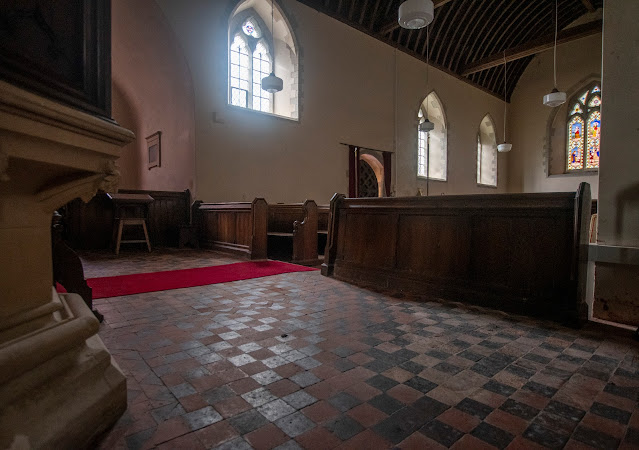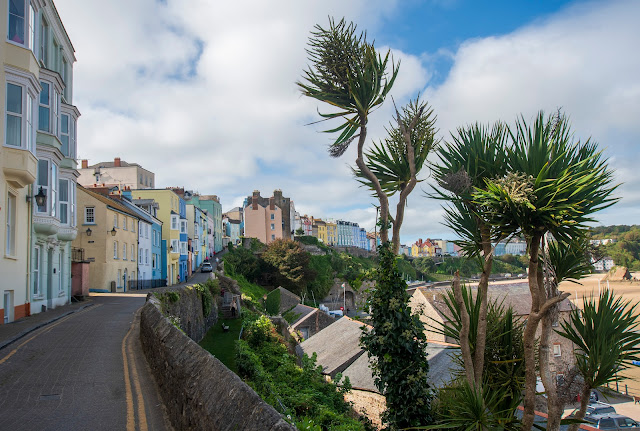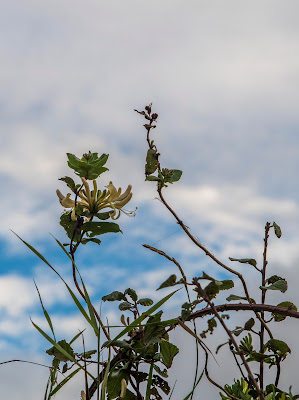Day two of our getaway dawned and after a leisurely breakfast there was only one thing on my mind. No, not the inexplicable periodic dull knocking in the cottage walls (no heating on, not the pipes), but church exploration! With ominous looking cloud cover, we decided to delay our plans and to visit nearby Tenby by an hour or so. I can't resist an old church.
We put on our shoes in the boot room, trying our best to ignore the ghostly knocking (best not give these things energy) and headed across the lane to St Elidyr's Church (aka St James and St Elidyr or Stackpole Elidor Church). The name is subject to some debate.
The church is Grade I listed and has medieval origins, although most of the original church structure, save for the 12th or 13th century tower and part of the chancel, has been absorbed into later additions. Note the 19th century lychgate designed by Christopher Hatton Turnor (1873 - 1940) in memory of John Frederick Vaughan, second Earl Cawdor, who died in 1881. Along the ridge are lead representations of the Galley of Lorne from the Cawdor arms. The designer was the nephew of the wife of the third Earl and was a much respected architect of his day, responsible, amongst other things, for designs for the Cairo museum. The gate is generally considered to be a significant example of art nouveau.
The church is cruciform in shape and nestles neatly into a wooded hillside.
As per usual, I had failed to do any research, although in fairness, our proximity to the church was something of a surprise.
Venturing inside, I was quickly inspired to reach for my camera.
Gareth at some point drifted from view. I wonder where he went?
I was intrigued by this view into the vestry through a broken pane of glass...
...and the casual storage of signage and church calendar event props in the pews.
The church has bi monthly services and so for much of the time, sits in silence in splendid isolation. I can't imagine there are many visitors, as evidenced by the cobwebs, paint patina and dusty, damp organ.
The stained glass filtered light was ethereal and danced on the walls like the aurora borealis.
On either side of the chancel was a male and female effigy mounted on tomb chests. These are identified as the founder of the church, Sir Elidor and his wife, Lady Elspeth. The style is considered to be much later than their period, but it wasn't uncommon for descendents to erect monuments to long dead forebears in contemporary style. You may just be able to see that the knight's legs are crossed. This is widely acknowledged to indicate that the knight had been to the crusades.
For me, the most fascinating part of the church was the Lort Chapel. This stone includes a dedication to Henrietta Campbell, the daughter of John Hooke Campbell of Banjeston. John Hooke Campbell was the nephew of Lord Cawdor (Welsh politician and art collector). He probably inherited his Welsh estate through his mother's family. He met a sudden death in 1795.
There we have the Macbeth connection. Thane of Cawdor is a title in the Peerage of Scotland. In Shakespeare's Macbeth, this title was given to Macbeth after the previous Thane of Cawdor was captured and executed for treason against King Duncan. The historical King Macbeth fought a Thane of Cawdor who died in battled, but he did not thereby acquire the title himself.
Inside lay these striking monuments of Roger Lort, Lord of the Manor of Stackpole, who died in 1613. His figure is depicted, facing his wife, Abertha. Beneath, their seven sons and five daughters, all in deep mourning.
At this point, the silence was deafening and I realised that I had in fact been alone for some time. Where had Gareth gone? Prone to mooching off without warning, I assumed he was exploring the graveyard....until a rattling bolt startled me and a slightly flustered Gareth finally emerged from an interior doorway. He had ascended all 98 steps to the top of the tower, the oldest part of the church and more slender in nature and had been unable to open the door upon his return. With nothing but bats for company, wild horses couldn't drag me up there!
We decided to carry on with our plans for the day and headed back outside. Just outside the door to the church was a recently deceased bat, unbelievably suspended in death in a spider's web.
Past the twisted Yew Tree and a hop, skip and a jump away, our car awaited. From country to coast - we wanted to pay a long overdue visit to the picturesque harbour town Tenby (Dinbych-y-pysgod meaning, "fortlet of the fish), known for its 13th century town walls and sandy shoreline.
By the time we arrived, just shy of 30 minutes later, the clouds had dispersed and for the remainder of the day, we basked in warm sunshine.
Very early in our relationship, Gareth and I would frequently visit family friends in this part of the world and spent many a night inside the town's characterful pubs before moving on to the nearby Night Owl nightclub (now looking distinctly jaded).
Tenby is renowned for its brightly coloured harbour facing buildings, but it's clear that the town's shops also got the memo! I don't know about you, but whenever I go to the coast, I get a sudden craving for boiled sugar and inflatable mammals!

Lunch was fish and chips (no pics, sorry, but you know what they look like), followed by a local beer at the Harbwr Brewery, tucked away in one of the myriad narrow alleyways.
I left behind a little lino cut print I'd created of The Crooked House to spread the word.
After sharing it on the campaign group page on my return home, I was amazed to receive an immediate comment from a group member living in Tenby. This story has legs!
So, to the main event, Tenby's stunning harbour and beaches. Along the sea front, the wind was gusty enough to remove Gareth's hat and we battled against it to reach the harbour.
But just look at that for a September sky. Pembrokeshire continued to defy the forecast and despite the wind, there was no need for a jacket.
Master of the Harbour! These coastal dwellers are power crazed.
September is a great time to visit the UK's coast if you're not a fan of crowds.The sandy beaches are extensive and incorporate the tidal island of St Catherine's (a limestone outcrop riddled with tidal caves) with its 19th century Palmerston Fort, sadly closed on the day of our visit. Palmerston Forts were prompted by Victorian concerns about the strength of the French Navy.
The island was owned by the Earl of Pembroke until the reign of Elizabeth I. Later ownership passed to the Corporation of Tenby, which took possession of a number of crown lands. In 1856, the only inhabitants were a few sheep, as, for many centuries the island housed only a tiny church. This was demolished in 1867 in order for St Catherine's Fort to be constructed.
Since 1962, a family trust has owned the island. Fun facts. It once operated as a zoo and in 2016 was transformed into a maximum security prison by the power of television for the BBC Sherlock episode The Final Problem.

Onwards and upwards we headed to the Castle Hill (now in ruins)....
...passing the bandstand (one for the BBAS)...
...taking in the views of St Catherine's Rock...
...and paid the briefest of visits to a former domestic building associated with the castle. The building, on the south slope, was rebuilt from the ruins by the Victorians as a school, but now operates as the oldest independent Museum and Art Gallery in Wales.
I loved this artist's studio adjoining the old castle walls, the artwork on the brickwork seemingly making a break for the freedom of the sky.
Here's the working lifeboat station, housing a Tamar class all weather lifeboat.
Feeling windswept and looking interesting, we headed back in to the fortified old town which was mercifully sheltered from the elements. I headed for the town's charity shops (nothing to report unfortunately) before exploring some of the more alluring courtyards and alleyways.
This one housed an artisan silver jewellery business and with its healthy fig tree, white washed steps and cobbled courtyard, had a distinctly Mediterranean vibe.
Finally, it was time to take our leave and we left the safety of the castle walls to track down our car.
Tenby you were a tonic!












































































